Investigation on Hydration and Mechanical Properties of Mortar Containing Limestone Powder and Fly Ash Based on the Coupled Chemical–Thermal–Mechanical Method
Abstract
:1. Introduction
2. Materials and Experiment
2.1. Materials
2.2. Experimental Method
2.2.1. Mix Proportions
2.2.2. Test Methods
2.3. Experimental Results
2.3.1. Compressive and Flexural Strength
2.3.2. Isothermal Calorimeter
2.3.3. Hydration Products
2.3.4. Pore Structure
3. Simulation Method
3.1. Chemical–Thermal–Mechanical Method
3.2. Random Pore Model
3.3. Calculation Parameters
4. Simulation Results and Discussion
4.1. Numerical Samples
4.2. Model Validation
4.2.1. Simulation of the “Hump-Type” Hydration Acceleration Stage
4.2.2. Elastic Modulus and Compressive Strength Evolution Simulation
4.3. Numerical Results and Discussion
4.3.1. Compression Strength Simulation
4.3.2. Failure Process under Uniaxial Compression
5. Conclusions
- (1)
- In the OPC-FA system, limestone powder provides the nucleation sites that can accelerate the hydration effect at an early age, and 10%~20% of limestone powder is appropriate while excessive replacement may have a negative influence. Combined with fly ash, limestone powder has a filling effect, also there exitsthe aluminate phase reaction, which can both reduce harmful pores in the mortar and optimize the pore structure.
- (2)
- In terms of cement-based materials, the coupled chemical–thermal–mechanical method can simulate the “hump-type” hydration stage of the composite mortar well, which is specifically caused by limestone powder. For the microstructure, the random pore model considers the pore differences between the ITZ and the mortar matrix, which can simulate the effect of harmful pores in the mortar.
- (3)
- Combined with the coupled chemical–thermal–mechanical method, the random pore model can simulate and predict the hydration characteristics and mechanical properties of the mortar at different hydration ages, according to the information of aggregate grade, hydration rate, and porosity. The prediction property is in good agreement with the experimental results. The method can also be applied in other cement-based materials, while the fitting parameters should be recalibrated.
Author Contributions
Funding
Acknowledgments
Conflicts of Interest
References
- Schneider, M.; Romer, M.; Tschudin, M.; Bolio, H. Cement and Concrete Research Sustainable cement production—Present and future. Cem. Concr. Res. 2011, 41, 642–650. [Google Scholar] [CrossRef]
- Xu, G.; Tian, Q.; Miao, J.; Liu, J. Early-age hydration and mechanical properties of high volume slag and fly ash concrete at different curing temperatures. Constr. Build. Mater. 2017, 149, 367–377. [Google Scholar] [CrossRef]
- Wang, D.; Shi, C.; Farzadnia, N.; Shi, Z.; Jia, H.; Ou, Z. A review on use of limestone powder in cement-based materials: Mechanism, hydration and microstructures. Constr. Build. Mater. 2018, 181, 659–672. [Google Scholar] [CrossRef]
- Heirman, G.; Vandewalle, L.; Van Gemert, D.; Boel, V.; Audenaert, K.; De Schutter, G.; Desmet, B.; Vantomme, J. Time-dependent deformations of limestone powder type self-compacting concrete. Eng. Struct. 2008, 30, 2945–2956. [Google Scholar] [CrossRef]
- Zajac, M.; Rossberg, A.; Le Saout, G.; Lothenbach, B. Influence of limestone and anhydrite on the hydration of Portland cements. Cem. Concr. Compos. 2014, 46, 99–108. [Google Scholar] [CrossRef]
- Vance, K.; Aguayo, M.; Oey, T.; Sant, G.; Neithalath, N. Hydration and strength development in ternary portland cement blends containing limestone and fly ash or metakaolin. Cem. Concr. Compos. 2013, 39, 93–103. [Google Scholar] [CrossRef]
- Bonavetti, V.; Donza, H.; Menéndez, G.; Cabrera, O.; Irassar, E.F. Limestone filler cement in low w/c concrete: A rational use of energy. Cem. Concr. Res. 2003, 33, 865–871. [Google Scholar] [CrossRef]
- De Weerdt, K.; Kjellsen, K.O.; Sellevold, E.; Justnes, H. Synergy between fly ash and limestone powder in ternary cements. Cem. Concr. Compos. 2011, 33, 30–38. [Google Scholar] [CrossRef]
- De Weerdt, K.; Sellevold, E.; Kjellsen, K.O.; Justnes, H. Fly ash-limestone ternary cements: Effect of component fineness. Adv. Cem. Res. 2011, 23, 203–214. [Google Scholar] [CrossRef]
- Irassar, E.F.; Violini, D.; Rahhal, V.F.; Milanesi, C.; Trezza, M.A.; Bonavetti, V.L. Influence of limestone content, gypsum content and fineness on early age properties of Portland limestone cement produced by inter-grinding. Cem. Concr. Compos. 2011, 33, 192–200. [Google Scholar] [CrossRef]
- He, Z.; Cai, R.; Chen, E.; Tang, S. The investigation of early hydration and pore structure for limestone powder wastes blended cement pastes. Constr. Build. Mater. 2019, 229, 116923. [Google Scholar] [CrossRef]
- Men, G.; Bonavetti, V.; Irassar, E.F. Strength development of ternary blended cement with limestone filler and blast-furnace slag. Cem. Concr. Compos. 2003, 25, 61–67. [Google Scholar]
- Bonavetti, V.; Donza, H.; Rahhal, V.; Irassar, E. Influence of initial curing on the properties of concrete containing limestone blended cement. Cem. Concr. Res. 2000, 30, 703–708. [Google Scholar] [CrossRef]
- Honorio, T.; Bary, B.; Benboudjema, F. Evaluation of the contribution of boundary and initial conditions in the chemo-thermal analysis of a massive concrete structure. Eng. Struct. 2014, 80, 173–188. [Google Scholar] [CrossRef]
- Zhou, W.; Duan, L.; Tang, S.W.; Chen, E.; Hanif, A. Modeling the evolved microstructure of cement pastes governed by diffusion through barrier shells of C–S–H. J. Mater. Sci. 2018, 54, 4680–4700. [Google Scholar] [CrossRef]
- Castilho, E.; Schclar, N.; Tiago, C.; Farinha, M.L.B. FEA model for the simulation of the hydration process and temperature evolution during the concreting of an arch dam. Eng. Struct. 2018, 174, 165–177. [Google Scholar] [CrossRef]
- Conceição, J.; Faria, R.; Azenha, M.; Mamede, F.; Souza, F. Early-age behaviour of the concrete surrounding a turbine spiral case: Monitoring and thermo-mechanical modelling. Eng. Struct. 2014, 81, 327–340. [Google Scholar] [CrossRef]
- Schutter, G.D.E. General hydration model for Portland cement and blast furnace slag cement. Cem. Concr. Res. 1995, 25, 593–604. [Google Scholar] [CrossRef]
- Cervera, M.; Oliver, J.; Prato, T. Thermo-Chemo-Mechanical Model for Concrete. I: Hydration and Aging. J. Eng. Mech. 1999, 125, 1018–1027. [Google Scholar] [CrossRef] [Green Version]
- Gaspar, A.; Lopez-Caballero, F.; Modaressi-Farahmand-Razavi, A.; Gomes-Correia, A. Methodology for a probabilistic analysis of an RCC gravity dam construction. Modelling of temperature, hydration degree and ageing degree fields. Eng. Struct. 2014, 65, 99–110. [Google Scholar] [CrossRef]
- Gawin, D.; Pesavento, F.; Schrefler, B.A. Hygro-thermo-chemo-mechanical modelling of concrete at early ages and beyond. Part II: Shrinkage and creep of concrete. Int. J. Numer. Methods Eng. 2006, 67, 332–363. [Google Scholar] [CrossRef]
- Zhou, W.; Feng, C.; Liu, X.; Liu, S.; Zhang, C. A macro-meso chemo-physical analysis of early-age concrete based on a fixed hydration model. Mag. Concr. Res. 2015, 68, 1–14. [Google Scholar] [CrossRef]
- Zhou, W.; Qi, T.; Liu, X.; Yang, S.; Feng, C. A meso-scale analysis of the hygro-thermo-chemical characteristics of early-age concrete. Int. J. Heat Mass Transf. 2019, 129, 690–706. [Google Scholar] [CrossRef]
- Zhou, W.; Zhao, C.; Liu, X.; Chang, X.; Feng, C. Mesoscopic simulation of thermo-mechanical behaviors in concrete under frost action. Constr. Build. Mater. 2017, 157, 117–131. [Google Scholar] [CrossRef]
- Bentz, D.P.; Waller, V.; De Larrard, F. Prediction of Adiabatic Temperature Rise in Conventional and High-Performance Concretes Using a 3-D Microstructural Model. Cem. Concr. Res. 1998, 28, 285–297. [Google Scholar] [CrossRef]
- Ulm, F.J.; Coussy, O. Modeling of thermochemomechanical couplings of concrete at early ages. J. Eng. Mech. 1995, 121, 785–794. [Google Scholar] [CrossRef]
- Mazars, J.; Pijaudier-Cabot, G. From damage to fracture mechanics and conversely: A combined approach. Int. J. Solids Struct. 1996, 33, 3327–3342. [Google Scholar] [CrossRef]
- Wang, X.F.; Yang, Z.J.; Yates, J.R.; Jivkov, A.P.; Zhang, C. Monte Carlo simulations of mesoscale fracture modelling of concrete with random aggregates and pores. Constr. Build. Mater. 2015, 75, 35–45. [Google Scholar] [CrossRef]
- Kemeny, J.; Cook, N.G.W. Effective moduli, non-linear deformation and strength of a cracked elastic solid. Int. J. Rock Mech. Min. Sci. 1986, 23, 107–118. [Google Scholar] [CrossRef]
- Luping, T. A study of the quantitative relationship between strength and pore-size distribution of porous materials. Cem. Concr. Res. 1986, 16, 87–96. [Google Scholar] [CrossRef]
- Turk, K.; Nehdi, M.L. Coupled effects of limestone powder and high-volume fly ash on mechanical properties of ECC. Constr. Build. Mater. 2018, 164, 185–192. [Google Scholar] [CrossRef]
- Bucci, O.M.; De Bonitatibus, A.; Vaccaro, V.G. Limestone-filled pozzolanic cement. Proc. Inst. Electr. Eng. 1973, 120, 1349–1354. [Google Scholar] [CrossRef]
- Wang, D.; Shi, C.; Farzadnia, N.; Jia, H.; Zeng, R.; Wu, Y.; Lao, L. A quantitative study on physical and chemical effects of limestone powder on properties of cement pastes. Constr. Build. Mater. 2019, 204, 58–69. [Google Scholar] [CrossRef]
- Foti, D.; Lerna, M.; Sabbà, M.F.; Vacca, V. Mechanical characteristics and water absorption properties of blast-furnace slag concretes with fly ashes or microsilica additions. Appl. Sci. 2019, 9. [Google Scholar] [CrossRef] [Green Version]
- Kalaw, M.E.; Culaba, A.; Hinode, H.; Kurniawan, W.; Gallardo, S.; Promentilla, M.A. Optimizing and characterizing geopolymers from ternary blend of philippine coal fly ash, coal bottom ash and rice hull ash. Materials (Basel) 2016, 9. [Google Scholar] [CrossRef]
- Martin, L.H.J.; Winnefeld, F.; Müller, C.J.; Lothenbach, B. Contribution of limestone to the hydration of calcium sulfoaluminate cement. Cem. Concr. Compos. 2015, 62, 204–211. [Google Scholar] [CrossRef]
- Ma, J.; Yu, Z.; Ni, C.; Shi, H.; Shen, X. Effects of limestone powder on the hydration and microstructure development of calcium sulphoaluminate cement under long-term curing. Constr. Build. Mater. 2019, 199, 688–695. [Google Scholar] [CrossRef]
- Pelletier-Chaignat, L.; Winnefeld, F.; Lothenbach, B.; Müller, C.J. Beneficial use of limestone filler with calcium sulphoaluminate cement. Constr. Build. Mater. 2012, 26, 619–627. [Google Scholar] [CrossRef]
- Bentz, D.P. Modeling the influence of limestone filler on cement hydration using CEMHYD3D. Cem. Concr. Compos. 2006, 28, 124–129. [Google Scholar] [CrossRef]
- Schöler, A.; Lothenbach, B.; Winnefeld, F.; Zajac, M. Hydration of quaternary Portland cement blends containing blast-furnace slag, siliceous fly ash and limestone powder. Cem. Concr. Compos. 2015, 55, 374–382. [Google Scholar] [CrossRef]
- Celik, K.; Hay, R.; Hargis, C.W.; Moon, J. Effect of volcanic ash pozzolan or limestone replacement on hydration of Portland cement. Constr. Build. Mater. 2019, 197, 803–812. [Google Scholar] [CrossRef]
- Muller, A.C.A.; Scrivener, K.L. A reassessment of mercury intrusion porosimetry by comparison with 1H NMR relaxometry. Cem. Concr. Res. 2017, 100, 350–360. [Google Scholar] [CrossRef]
- Phung, Q.T.; Maes, N.; Seetharam, S. Pitfalls in the use and interpretation of TGA and MIP techniques for Ca-leached cementitious materials. Mater. Des. 2019, 182, 108041. [Google Scholar] [CrossRef]
- Diamond, S. Mercury porosimetry. An inappropriate method for the measurement of pore size distributions in cement-based materials. Cem. Concr. Res. 2000, 30, 1517–1525. [Google Scholar] [CrossRef]
- Kaufmann, J.; Loser, R.; Leemann, A. Analysis of cement-bonded materials by multi-cycle mercury intrusion and nitrogen sorption. J. Colloid Interface Sci. 2009, 336, 730–737. [Google Scholar] [CrossRef]
- Liu, S.; Kong, Y.; Wang, L. A comparison of hydration properties of cement-low quality fly ash binder and cement-limestone powder binder. J. Therm. Anal. Calorim. 2014, 116, 937–943. [Google Scholar] [CrossRef]
- Zhang, Y.; Ye, G. Effect of Limestone Powder on Microstructure of Ternary Cementitious System. In Proceedings of the Second International Conference on Sustainable Construction Materials: Design, Performance, and Application, Beijing, China, 18–22 October 2012; Volume 66, pp. 37–39. [Google Scholar]
- Elgalhud, A.A.; Dhir, R.K.; Ghataora, G. Limestone addition effects on concrete porosity. Cem. Concr. Compos. 2016, 72, 222–234. [Google Scholar] [CrossRef]
- D’Aloia, L.; Chanvillard, G. Determining the “apparent” activation energy of concrete. Cem. Concr. Res. 2002, 32, 1277–1289. [Google Scholar] [CrossRef]
- Laidler, K.J. The development of the arrhenius equation. J. Chem. Educ. 1984, 61, 494–498. [Google Scholar] [CrossRef]
- Bullard, J.W.; Jennings, H.M.; Livingston, R.A.; Nonat, A.; Scherer, G.W.; Schweitzer, J.S.; Scrivener, K.L.; Thomas, J.J. Mechanisms of cement hydration. Cem. Concr. Res. 2011, 41, 1208–1223. [Google Scholar] [CrossRef]
- Zhou, W.; Qi, T.; Liu, X.; Feng, C.; Yang, S. A hygro-thermo-chemical analysis of concrete at an early age and beyond under dry-wet conditions based on a fixed model. Int. J. Heat Mass Transf. 2017, 115, 488–499. [Google Scholar] [CrossRef]
- De Weerdt, K.; Haha, M.B.; Le Saout, G.; Kjellsen, K.O.; Justnes, H.; Lothenbach, B. Hydration mechanisms of ternary Portland cements containing limestone powder and fly ash. Cem. Concr. Res. 2011, 41, 279–291. [Google Scholar] [CrossRef]
- Thongsanitgarn, P.; Wongkeo, W.; Chaipanich, A.; Poon, C.S. Heat of hydration of Portland high-calcium fly ash cement incorporating limestone powder: Effect of limestone particle size. Constr. Build. Mater. 2014, 66, 410–417. [Google Scholar] [CrossRef]
- Antoni, M.; Rossen, J.; Martirena, F.; Scrivener, K. Cement substitution by a combination of metakaolin and limestone. Cem. Concr. Res. 2012, 42, 1579–1589. [Google Scholar] [CrossRef]
- De Schutter, G. Degree of hydration based Kelvin model for the basic creep of early age concrete. Mater. Struct. 1999, 32, 260–265. [Google Scholar] [CrossRef]
- Torrenti, J.M.; Benboudjema, F. Mechanical threshold of cementitious materials at early age. Mater. Struct. Constr. 2005, 38, 299–304. [Google Scholar] [CrossRef] [Green Version]
- De Schutter, G.; Taerwe, L. Degree of hydration-based description of mechanical properties of early age concrete. Mater. Struct. 1996, 29, 335–344. [Google Scholar] [CrossRef]
- Gasch, T.; Malm, R.; Ansell, A. A coupled hygro-thermo-mechanical model for concrete subjected to variable environmental conditions. Int. J. Solids Struct. 2016, 91, 143–156. [Google Scholar] [CrossRef]
- Kendall, K.; Howard, A.J.; Birchall, J.D. Relation between Porosity, Microstructure and Strength, and the Approach to Advanced Cement-Based Materials. Philos. Trans. R. Soc. London. Ser. A Math. Phys. Sci. 1983, 153, 139–153. [Google Scholar]
- Roff, W.J.; Scott, J.R. Flexural strength and porosity of cements. Fibres Film. Plast. Rubbers 1971, 605–607. [Google Scholar] [CrossRef]
- Ollivier, J.P.; Maso, J.; Bourdette, B. Interfacial Transition Zone in Concrete. Adv. Cem. Based Mater. 1996, 7355. [Google Scholar] [CrossRef]
- Ji, S.; Gu, Q.; Xia, B. Porosity dependence of mechanical properties of solid materials. J. Mater. Sci. 2006, 41, 1757–1768. [Google Scholar] [CrossRef]
- Bentz, D.P. Transient plane source measurements of the thermal properties of hydrating cement pastes. Mater. Struct. 2007, 40, 1073–1080. [Google Scholar] [CrossRef]
- Vrdoljak, M. On Hashin-Shtrikman bounds for mixtures of two isotropic materials. Nonlinear Anal. Real World Appl. 2010, 11, 4597–4606. [Google Scholar] [CrossRef]
- Liao, K.Y.; Chang, P.K.; Peng, Y.N.; Yang, C.C. A study on characteristics of interfacial transition zone in concrete. Cem. Concr. Res. 2004, 34, 977–989. [Google Scholar] [CrossRef]
- Hussin, A.; Poole, C. Petrography evidence of the interfacial transition zone (ITZ) in the normal strength concrete containing granitic and limestone aggregates. Constr. Build. Mater. 2011, 25, 2298–2303. [Google Scholar] [CrossRef]
- Li, W.; Xiao, J.; Sun, Z.; Kawashima, S.; Shah, S.P. Interfacial transition zones in recycled aggregate concrete with different mixing approaches. Constr. Build. Mater. 2012, 35, 1045–1055. [Google Scholar] [CrossRef] [Green Version]
- Grondin, F.; Matallah, M. How to consider the Interfacial Transition Zones in the finite element modelling of concrete? Cem. Concr. Res. 2014, 58, 67–75. [Google Scholar] [CrossRef] [Green Version]
- Das, S.; Aguayo, M.; Dey, V.; Kachala, R.; Mobasher, B.; Sant, G.; Neithalath, N. The fracture response of blended formulations containing limestone powder: Evaluations using two-parameter fracture model and digital image correlation. Cem. Concr. Compos. 2014, 53, 316–326. [Google Scholar] [CrossRef]

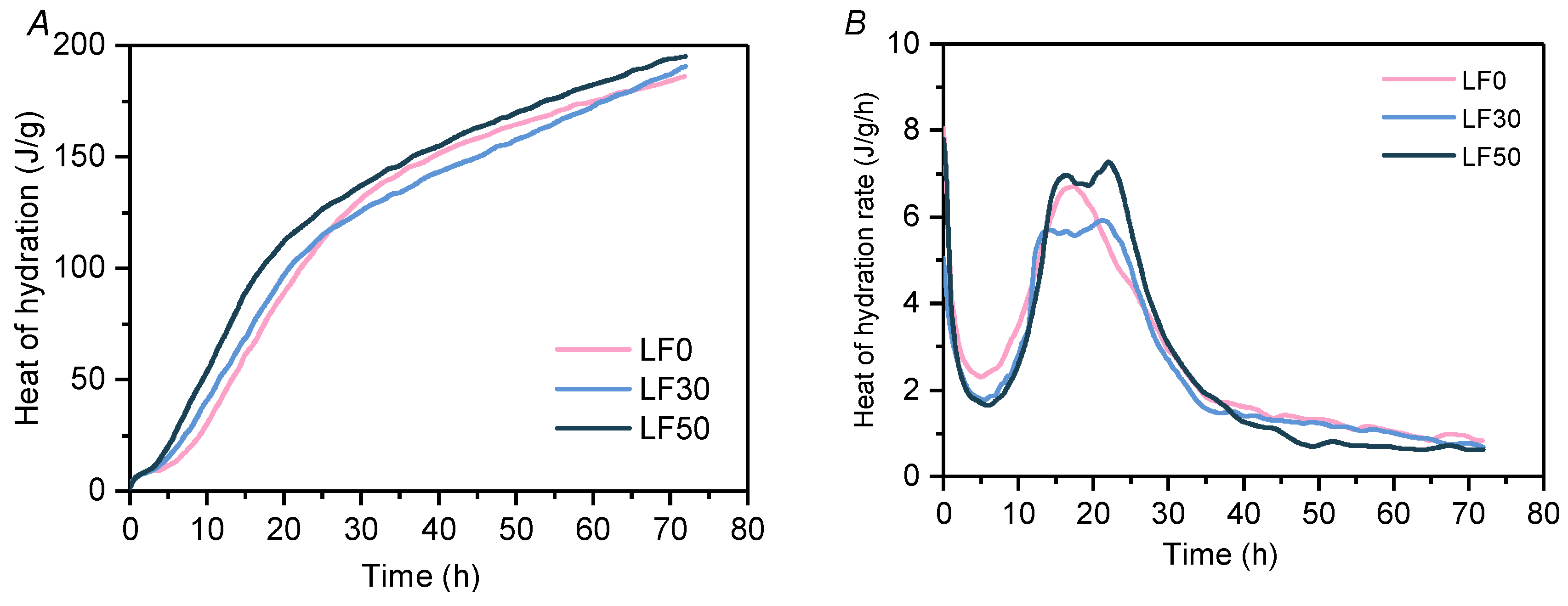

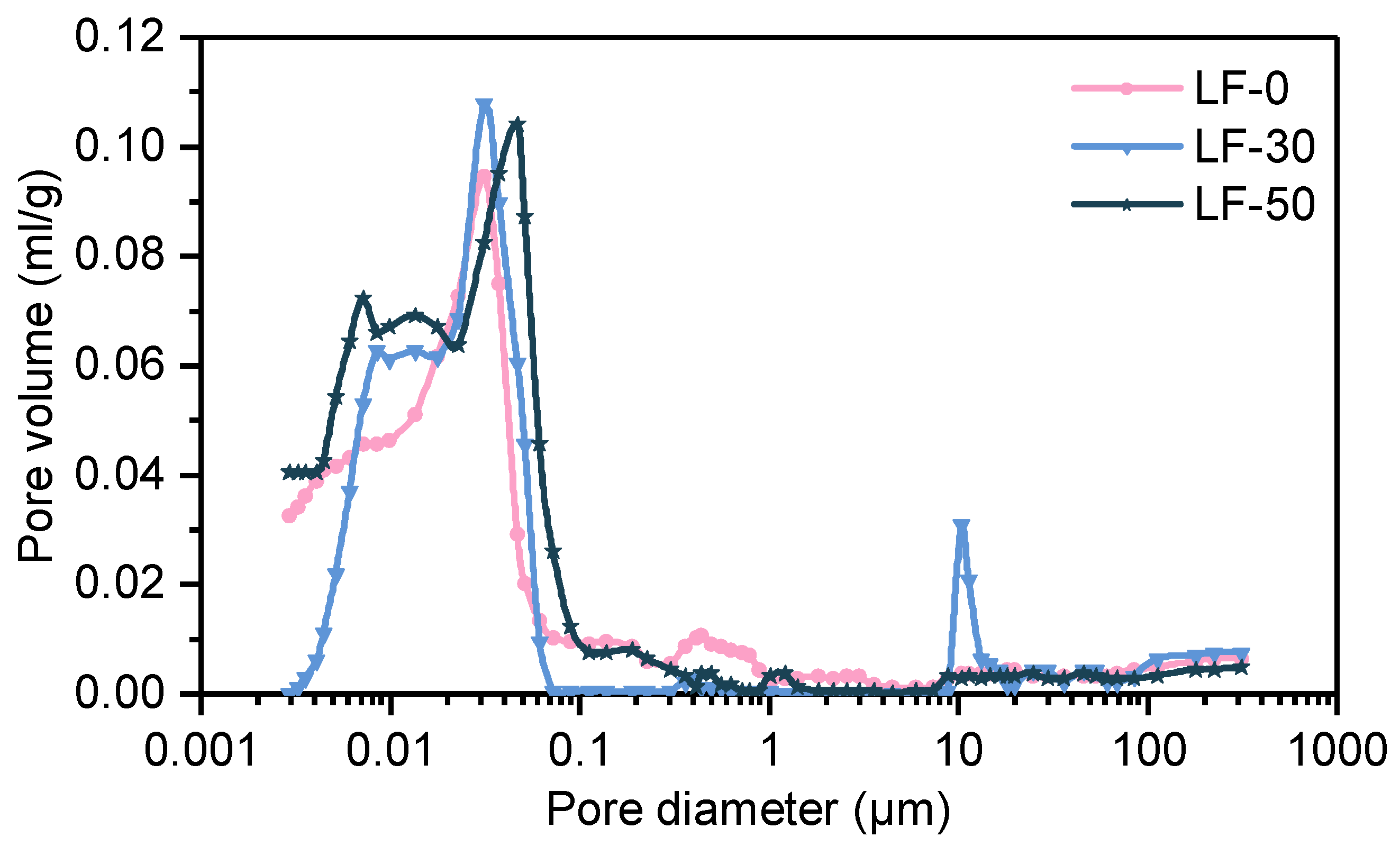
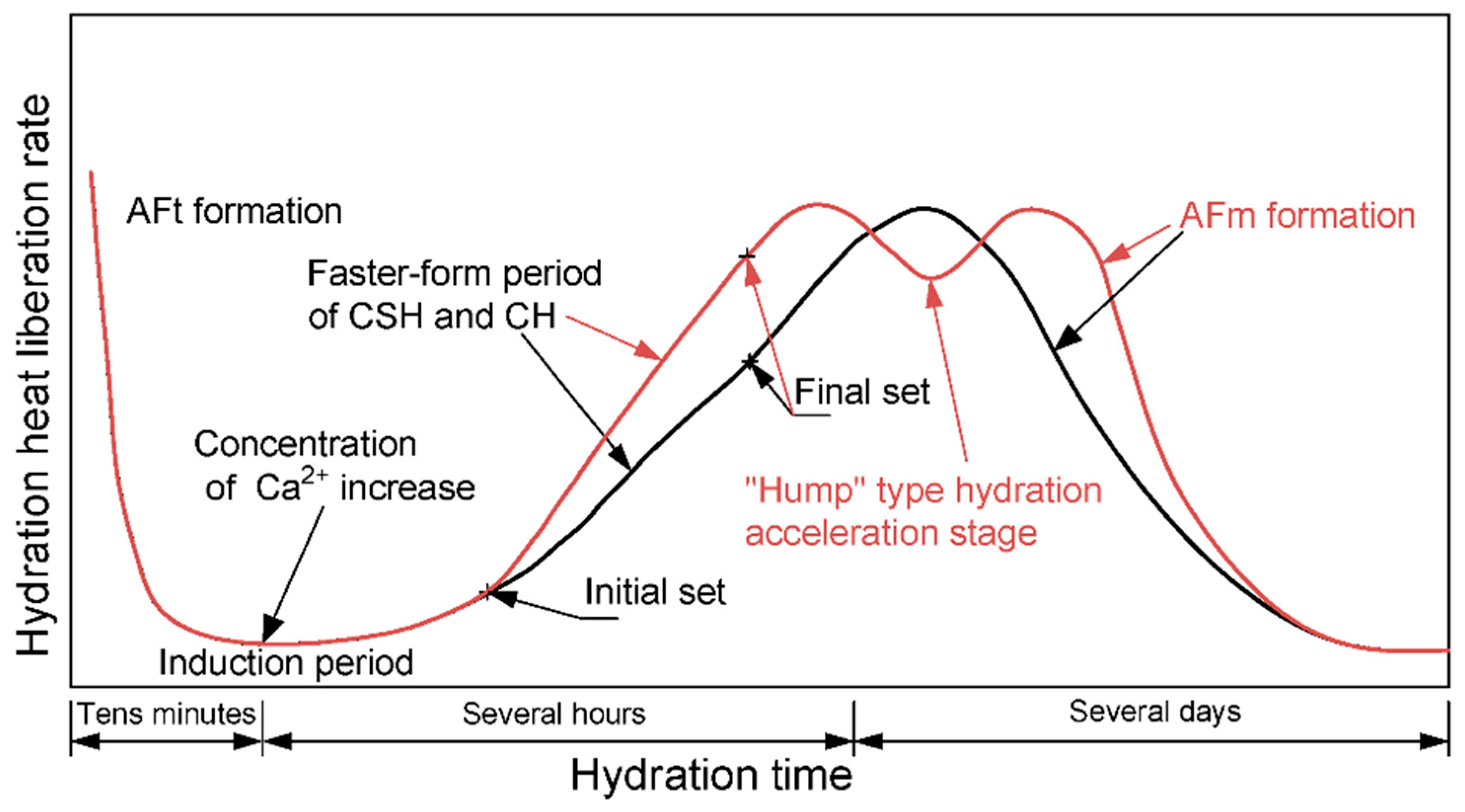

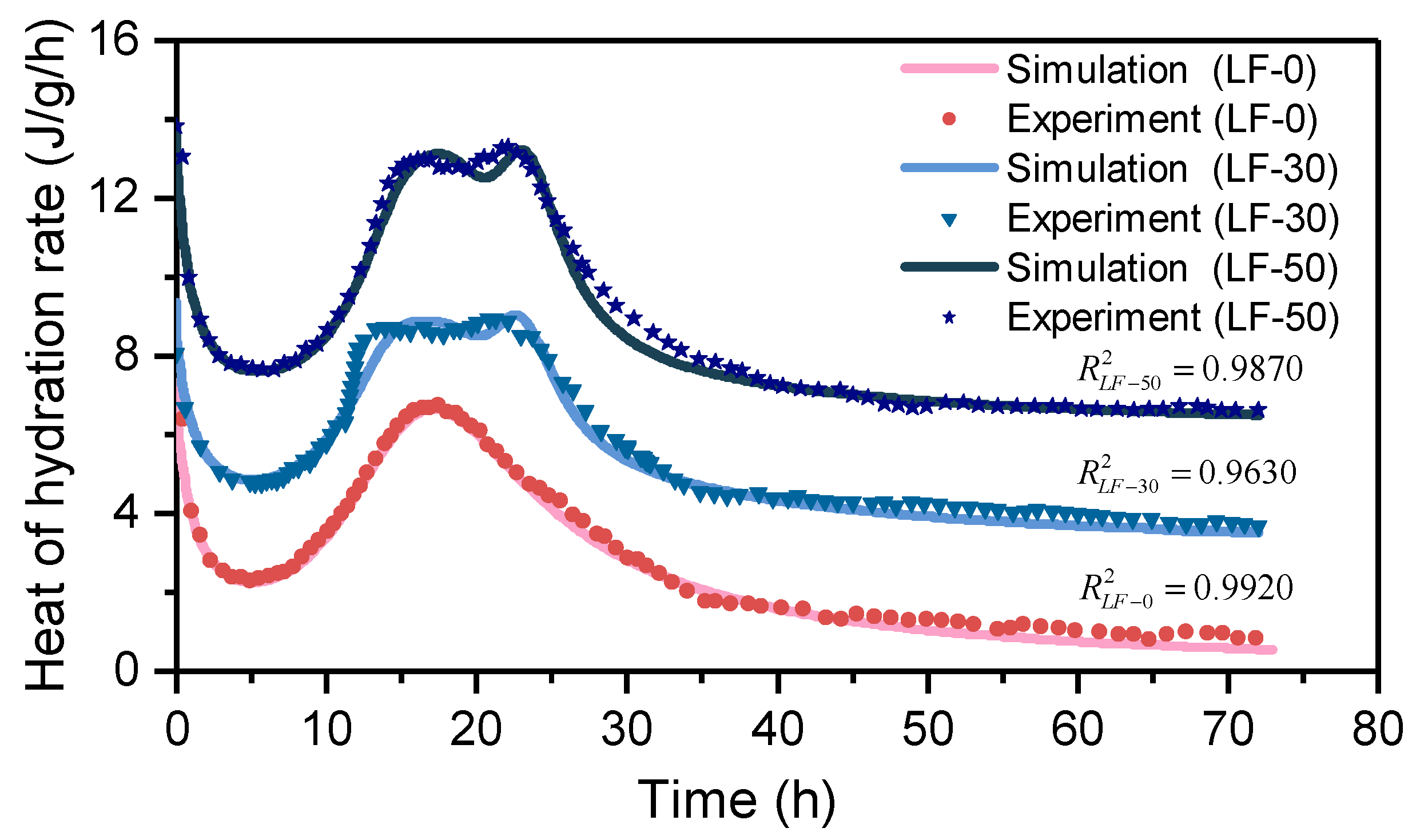
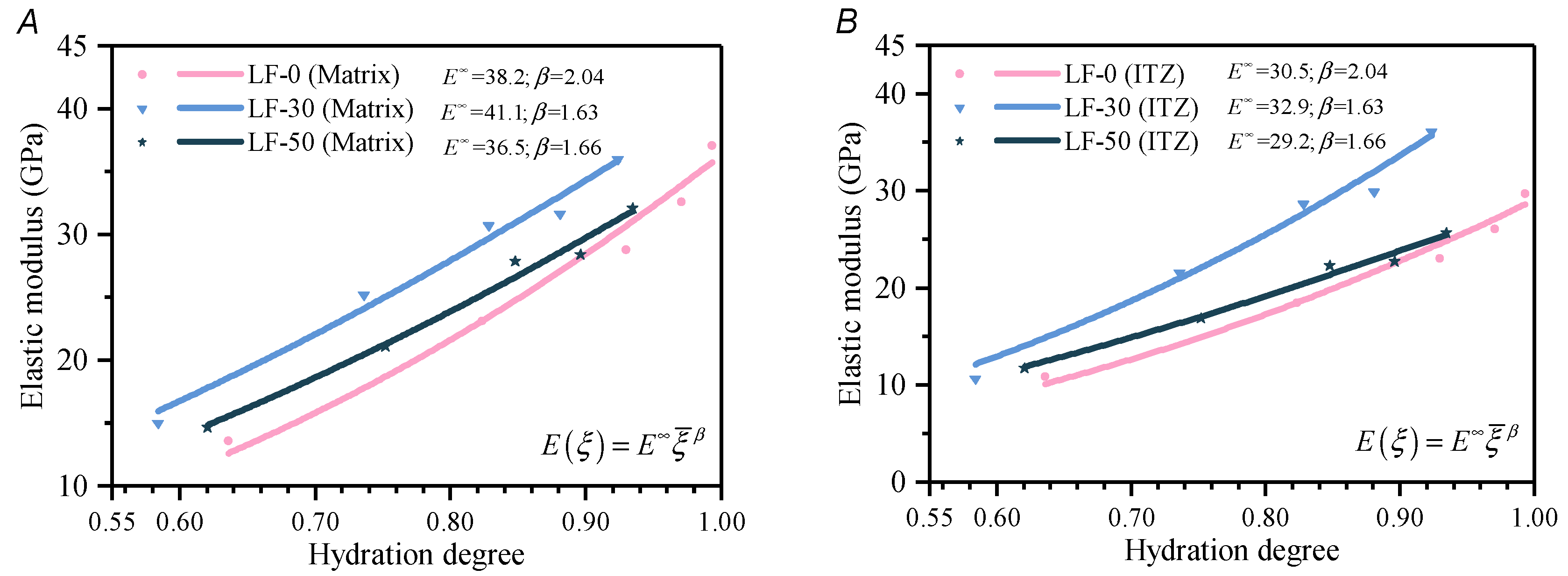


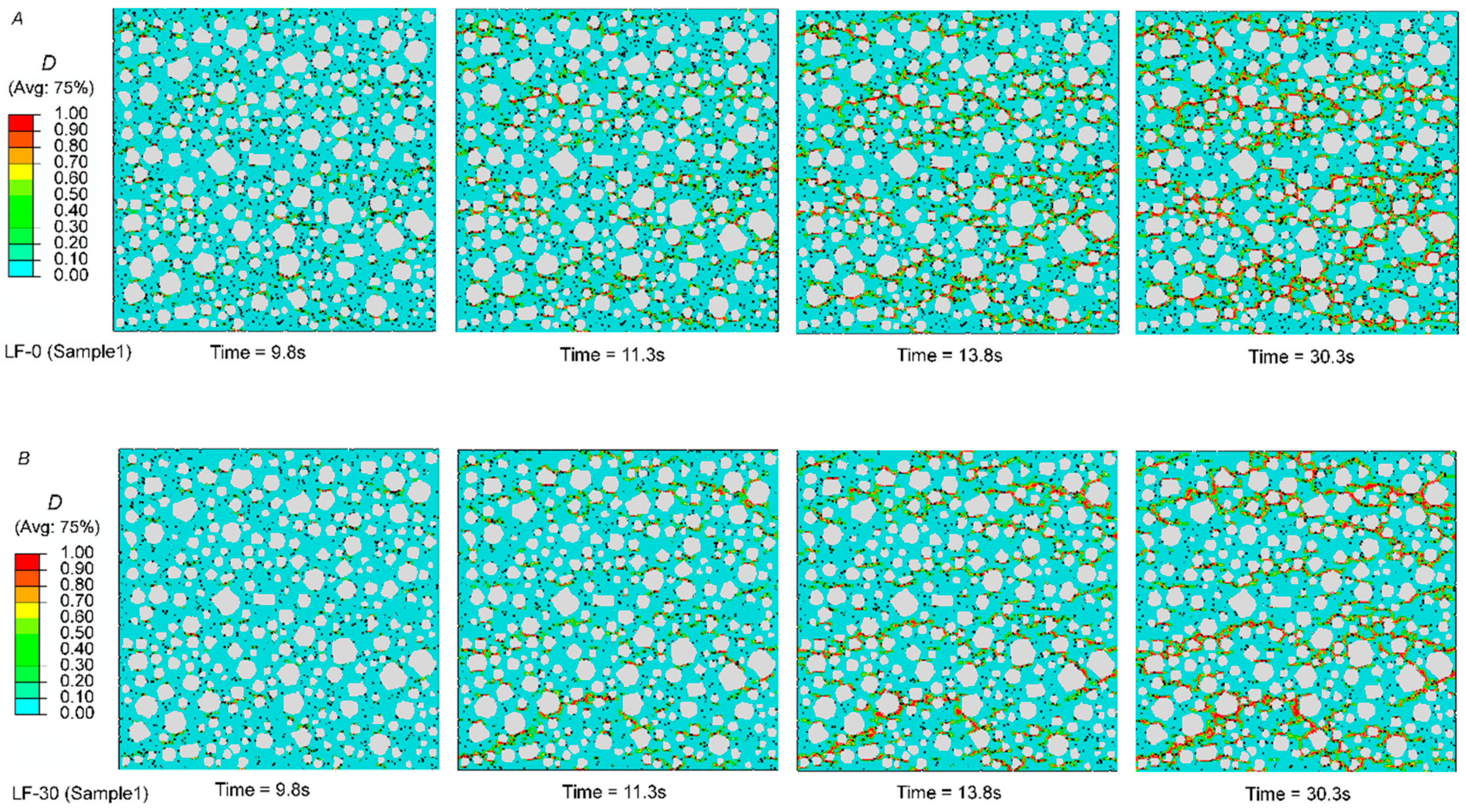

| Composition | SiO2 | Al2O3 | Fe2O3 | CaO | SO3 | Na2O | K2O | MgO | TiO2 | LOI |
|---|---|---|---|---|---|---|---|---|---|---|
| OPC | 22.75 | 7.92 | 4.03 | 55.60 | 2.82 | 0.19 | 0.86 | 2.09 | 0.33 | 3.16 |
| LP | 2.50 | 0.60 | 0.36 | 54.03 | 0.01 | 0.08 | 0.10 | 0.54 | 0.05 | 41.59 |
| FA | 53.41 | 25.79 | 4.28 | 2.60 | 0.30 | 0.42 | 1.38 | 2.79 | — | 3.67 |
| Sample | C (g) | LP (g) | LP (%) | FA (g) | FA (%) | S (g) | W (g) | Fluidity (mm) |
|---|---|---|---|---|---|---|---|---|
| OPC | 450 | 0 | 0 | 0 | 0 | 1350 | 225 | -- |
| LF-0 | 225 | 0 | 0 | 225 | 50 | 1350 | 225 | 173 |
| LF-10 | 225 | 45 | 10 | 180 | 40 | 1350 | 225 | 178 |
| LF-20 | 225 | 90 | 20 | 135 | 30 | 1350 | 225 | 182 |
| LF-30 | 225 | 135 | 30 | 90 | 20 | 1350 | 225 | 186 |
| LF-40 | 225 | 180 | 40 | 45 | 10 | 1350 | 225 | 189 |
| LF-50 | 225 | 225 | 50 | 0 | 0 | 1350 | 225 | 193 |
| Sample | Porosity (by Volume) | Total Intruded Volume of Hg | Pore Distribution (by Volume) (%) | |||
|---|---|---|---|---|---|---|
| Diameter of Pore (μm) | ||||||
| (%) | (mL·g−1) | <0.02 | 0.02–0.05 | 0.05–0.2 | >0.2 | |
| LF-0 | 18.62 | 0.0901 | 47.38 | 27.24 | 7.77 | 17.61 |
| LF-30 | 16.25 | 0.0785 | 48.05 | 35.74 | 3.43 | 12.78 |
| LF-50 | 21.64 | 0.1052 | 48.79 | 33.35 | 9.99 | 7.87 |
| Component | (kg·m−3) | (k·J·m−3·°C−1) | (J·h−1·m−1·K−1) |
|---|---|---|---|
| water | 1000 | 4180 | 2160 |
| cement | 3180 | 2415 | 5580 |
| aggregate | 2681 | 2267 | 820 |
| fly ash | 2473 | 2190 | 4176 |
| limestone powder | 2760 | 2208 | 8800 |
| Sample | |||||||||||
|---|---|---|---|---|---|---|---|---|---|---|---|
| 107 h−1 | - | - | - | - | - | - | - | - | (J·g−1) | (K) | |
| LF-0 | 9.0 | 0.0059 | −0.105 | 13.32 | 1.0 | — | — | — | — | 244 | 5000 |
| LF-30 | 11.0 | 0.0038 | −0.085 | 15.20 | 1.0 | 0.14 | 0.37 | 0.105 | 14.5 | 254 | 5000 |
| LF-50 | 14.5 | 0.0038 | −0.100 | 15.50 | 1.0 | 0.12 | 0.40 | 0.105 | 14.5 | 259 | 5000 |
© 2020 by the authors. Licensee MDPI, Basel, Switzerland. This article is an open access article distributed under the terms and conditions of the Creative Commons Attribution (CC BY) license (http://creativecommons.org/licenses/by/4.0/).
Share and Cite
Zhou, W.; Tian, W.; Qi, T.; Liu, S.; Feng, C.; Ma, G.; Chang, X. Investigation on Hydration and Mechanical Properties of Mortar Containing Limestone Powder and Fly Ash Based on the Coupled Chemical–Thermal–Mechanical Method. Materials 2020, 13, 4387. https://doi.org/10.3390/ma13194387
Zhou W, Tian W, Qi T, Liu S, Feng C, Ma G, Chang X. Investigation on Hydration and Mechanical Properties of Mortar Containing Limestone Powder and Fly Ash Based on the Coupled Chemical–Thermal–Mechanical Method. Materials. 2020; 13(19):4387. https://doi.org/10.3390/ma13194387
Chicago/Turabian StyleZhou, Wei, Wenxiang Tian, Tianqi Qi, Shuhua Liu, Chuqiao Feng, Gang Ma, and Xiaolin Chang. 2020. "Investigation on Hydration and Mechanical Properties of Mortar Containing Limestone Powder and Fly Ash Based on the Coupled Chemical–Thermal–Mechanical Method" Materials 13, no. 19: 4387. https://doi.org/10.3390/ma13194387
APA StyleZhou, W., Tian, W., Qi, T., Liu, S., Feng, C., Ma, G., & Chang, X. (2020). Investigation on Hydration and Mechanical Properties of Mortar Containing Limestone Powder and Fly Ash Based on the Coupled Chemical–Thermal–Mechanical Method. Materials, 13(19), 4387. https://doi.org/10.3390/ma13194387






